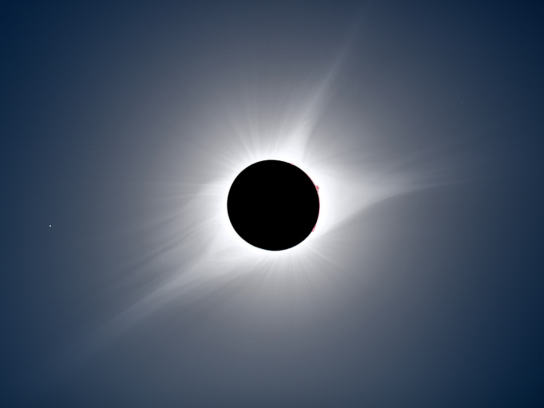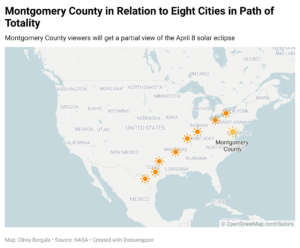
Marylanders will get a partial view of the total solar eclipse April 8 when the moon completely blocks the face of the sun, plunging parts of the country into darkness.
About 31 million Americans across 31 states will be in the “path of totality,” meaning they will have the most direct view of the eclipse. While Maryland is not among the states in the path, residents will see 89.7% of the sun covered during the maximum view at around 3:20 p.m.
Safety
People who want to view the solar eclipse must look through eclipse glasses to avoid eye damage from staring directly at the sun, according to NASA.
Free eclipse glasses are available for pick up at the Rockville Memorial library starting at 4 p.m. Wednesday as long as supplies last, at Damascus Library Thursday at 6:30 p.m. and during the eclipse at 2:45 p.m. at Long Branch Library.
Eclipse glasses are thousands of times darker than regular sunglasses, which are not safe to use while looking at the sun. It’s also important to avoid looking at the sun through a camera lens, telescope or binoculars while wearing eclipse glasses because the concentrated solar rays will burn through the filter and can cause injury.
While the number of people who suffered eye problems after the 2017 solar eclipse was few, a survey from The Ohio State University Wexner Medical Center found nearly 30% of Americans are unaware that looking at a solar eclipse without adequate protection can cause permanent eye damage.

April’s Eclipse Compared to the 2017 Eclipse
Unlike the 2017 solar eclipse, this year’s path of totality is wider and will pass over more densely populated areas. Around 31.6 million people live in the path of totality this year compared to 12 million in 2017, according to NASA.
While eclipse time varies by location, 2017’s eclipse saw a maximum eclipse time of 2 minutes and 42 seconds. April’s eclipse is predicted to have up to 4 minutes and 28 seconds of totality. During this time, the sky will darken as if it were dawn or dusk.
The sun’s magnetic field flips about every 11 years and causes a cycle of increasing then decreasing solar activity, according to NASA. The 2017 solar eclipse happened during a solar minimum, which meant fewer solar flares and coronal mass ejections from the sun. But this year’s eclipse will be near solar maximum. Viewers will have a better change of seeing prominences, or bright, pink curls coming off the sun.
Events in the County
- Gaithersburg Library will host educational activities Tuesday at 4:30 p.m. with information about solar eclipse and how to safely view them.
- Maggie Nightingale Library will host Rob Parks, NASA Eclipse Ambassador and Deputy Director of the George Mason Observatory, for a presentation about the upcoming solar eclipse Tuesday at 6:30 p.m.
- Damascus Library will offer free solar eclipse glasses and will host Dorian Janney, senior NASA Earth Science Education and Communications Specialist, who will talk about the basics of solar eclipses Thursday at 6:30 p.m.
- Kensington Park Library will offer solar eclipse and space crafts Friday at 4:30 p.m.
- Potomac Library will have hands-on science and craft activities Saturday at 11 a.m.
- The Gaithersburg Latitude Observatory will host a viewing event Monday from 2 p.m. until 4:30 p.m. Attendees are advised to bring a red flashlight instead of a bright flashlight to minimize disturbance for other viewers
More information about county events is available here.

